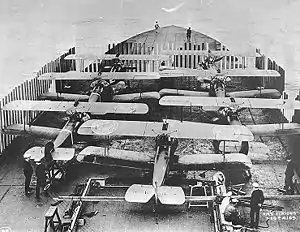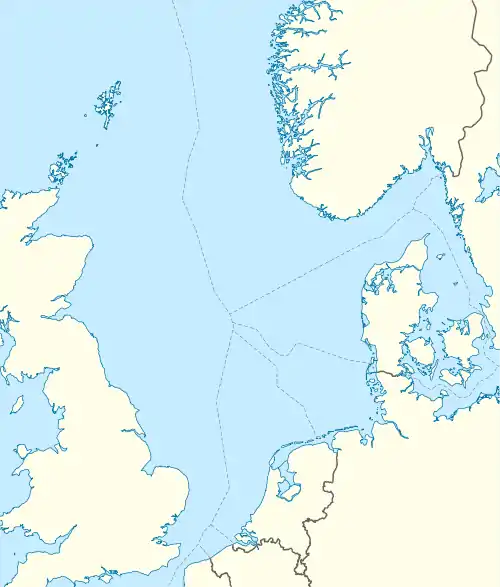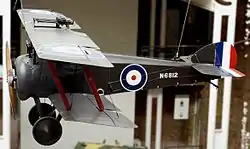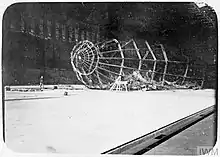Tondern raid
The Tondern raid or Operation F.7, was a British bombing raid mounted by the Royal Navy and Royal Air Force against the Imperial German Navy airship base at Tønder, Denmark, then a part of Germany. The airships were used for the strategic bombing of Britain. It was the first attack in history by aircraft from an aircraft carrier. On 19 July 1918, seven Sopwith Camels took off from the converted battlecruiser HMS Furious. For the loss of one man, the British destroyed Zeppelins, L 54 and L 60 and a captive balloon.
| Tondern Raid | |||||||
|---|---|---|---|---|---|---|---|
 The seven Sopwith Camels on the flight deck of HMS Furious en route to the Tondern raid | |||||||
| |||||||
| Belligerents | |||||||
|
|
| ||||||
| Commanders and leaders | |||||||
|
|
| ||||||
| Strength | |||||||
| 7 aircraft |
2 airships 1 captive balloon | ||||||
| Casualties and losses | |||||||
|
1 drowned 3 interned 1 aircraft damaged 3 aircraft interned 2 aircraft abandoned 1 aircraft lost at sea |
4 wounded 2 airships destroyed 1 captive balloon destroyed 2 hangars damaged | ||||||
| First attack from an aircraft carrier[1] | |||||||
 Location of Tondern (now Tønder, Denmark) | |||||||
Background
In March 1918 the battlecuiser HMS Furious joined the Grand Fleet at Scapa Flow, flying the flag of the Rear-Admiral Commanding Aircraft, Richard Phillimore. Furious had been converted for use as an aircraft carrier during her construction, with a flight deck forward of her main superstructure. During 1917 the carrier had been equipped with Sopwith Camel 2F.1a, naval variant of the Sopwith Camel. These partially replaced the Sopwith 1½ Strutter.[2] In late 1917 a second flight deck was fitted aft, landing on which proved "almost as hazardous as ditching in the sea".[3] Until such need arose however, she was dispatched on reconnaissance missions off the Heligoland Bight searching for minefields and looking for evidence of counter-mining by the Germans.[4]
An attack on the bases of the Naval Airship Division of the Imperial German Navy (Kaiserliche Marine) was allegedly suggested to Rear-Phillimore by his Royal Air Force staff officer Lieutenant-Colonel Robert Clark-Hall and one of his pilots, Squadron Commander Richard Bell-Davies, VC. Clark-Hall received Phillimore's approval and that of the Commander-in-Chief of the Grand Fleet David Beatty.[4][lower-alpha 1]
Operation F.6
It was originally planned to use 1½ Strutters in an attack but these were too valuable for reconnaissance and Sopwith Camels were substituted, whose range meant an attack on the airship base at Tønder. The initial attack on Tønder, named Operation F.6 called for two waves of four aircraft, each pilot receiving special training. One of the pilots, Major Moore, was posted away before the operation's scheduled date of 29 June 1918, by which time it was too late to train a replacement. Training consisted of bombing runs on the airfield at Turnhouse, where the outlines of Tondern's three airship sheds were marked. The pilots were Captains W. D. Jackson, W. F. Dickson|William Dixon, Bernard Smart and T. K. Thyne, and Lieutenants N. E. Williams, S. Dawson and W. A. Yeulett. On 27 June Furious put to sea from Rosyth, escorted by the 1st Light Cruiser Squadron and eight destroyers from the 13th Destroyer Flotilla. On 29 June the ships reached the flying off point but with Force 6 winds blowing flying was deemed impossible and the operation was called off.[4]
Operation F.7
The mission was attempted again, renamed Operation F.7, and Furious went to sea at 12:03 on 17 July. This time she was escorted by "Force B", including a division of the 1st Battle Squadron (all the new Revenge-class battleships), the 7th Light Cruiser Squadron and a destroyer screen. HMS Resolution's' "Y" turret guns had been loaded with a special shrapnel shell for use against airships. During the passage the destroyer HMS Valentine investigated a reported submarine contact but nothing else untoward occurred.[4]
At 03:04 in the morning of 18 July Furious was ready to fly off her Camels when a thunderstorm struck. Rather than cancel the operation, it was decided to delay it twenty-four hours and Furious and her destroyer screen fell back on Force B.[4] The combined squadron cruised out of sight off the Danish coast until the morning of 19 July and in worsening weather conditions Furious flew off her Camels between 03:13 and 03:21. The first flight consisted of Jackson, Dickson and Williams; the second of Smart, Dawson, Yeulett and Thyne. Thyne was forced to turn around with engine trouble before reaching the target and ditched his aircraft before being recovered.[lower-alpha 2]

The first three aircraft arrived over Tondern at 04:35, taking the base by surprise. There were three airship sheds, codenamed by the Germans as Toska,Tobia and Toni. Toska, the largest one, was a double shed and housed the airships L.54 and L.60. Tobias contained a captive balloon and Toni was in the process of being dismantled. The first wave attacked Toska; three bombs hit the shed and detonated the gas bags of L.54 and L.60, destroying them by fire but not causing them to explode and destroy the shed. Another bomb from the first wave hit Tobias and damaged the balloon. The second wave destroyed the captive balloon afire and scored a number of near misses on a wagon loaded with hydrogen cylinders. Despite the loss of the two airships only four men injured.[5]
During the attack ground fire was directed at both waves but the only damage was an undercarriage wheel shot off a Camel from the second wave. Williams, Jackson and Dawson, in the belief that they had insufficient fuel to reach the British squadron offshore, headed for Denmark and landed there. Dickson, Yuelett and Smart flew to sea to find the British ships. Dickson ditched at 05:55 and Smart, having suffered engine trouble at 06:30. Yeulett was not heard from again and presumed drowned and it was supposed that he had been forced to ditch prematurely through fuel exhaustion.[5] The British squadron waited for the other pilots until the time when the Camels fuel would have run out, then after 07:00 the ships took cruising formation and made for home.[6]
Aftermath

The German Naval Airship Division quickly had the double hangar Toska repaired but Tondern was abandoned, only to be used only as an emergency landing site. Defences at the other bases were improved and at Nordholz a swathe of the countryside near Nordholz Naval Airbase was burned off to prevent it being set alight by bombs. The British conducted no other carrier raids during the war but other raids were planned. From 1917 a raid on the German High Seas Fleet was being planned using the new torpedo-carrying Sopwith Cuckoo. The Cuckoo was not available in sufficient numbers until early 1919 and the project was abortive. The concept was revived during the Second World War and eventually resulted in the Battle of Taranto a raid on the ship of the Italian Regia Marina in 1940. Dickson and Yeulett were awarded the DSO, whilst Smart received the bar to his DSO. Yeulett's body was later recovered from the sea.[7]
Notes
- On 1 April 1918 the Royal Naval Air Service was amalgamated with the Royal Flying Corps to form the Royal Air Force. RNAS officers who had been part of the Navy hierarchy became members of the RAF.
- Despite Furious having a landing deck aft, returning aircraft were expected to ditch in the sea, and the pilot would be rescued by a destroyer, and the plane recovered if possible.[5]
Footnotes
- Probert, p. 46
- Layman 1973, p. 380.
- Till 1979, p. 62.
- Layman 1973, p. 381.
- Layman 1973, p. 382.
- Layman 1973, p. 383.
- Flightglobal/Archive – Aviation History – 1918
References
- Beatty, Admiral Sir David (1918). Grand Fleet Battle Instructions. London: H.M.S.O. OCLC 694732431.
- Layman, R. L. (1973). "Furious and the Tondern Raid". Warship International. Vol. X no. 4. pp. 374–385. ISSN 0043-0374.
- Till, Geoffrey (1979). Air Power and the Royal Navy, 1914–1945: A Historical Survey. London: Macdonald and Jane's. ISBN 978-0-354-01204-1.
Further reading
- Jones, H. A. (2009) [1937]. The War in the Air: Being the Story of the Part played in the Great War by the Royal Air Force. History of the Great War Based on Official Documents by Direction of the Historical Section of the Committee of Imperial Defence. VI (facs. repr. Imperial War Museum Department of Printed Books and Naval & Military Press, Uckfield ed.). London: Clarendon Press. ISBN 978-1-84342-417-8.
- Newbolt, H. J. (2003) [1931]. Naval Operations (with accompanying map case). History of the Great War Based on Official Documents by Direction of the Historical Section of the Committee of Imperial Defence. V (facs. repr. Imperial War Museum Department of Printed Books and Naval & Military Press, Uckfield ed.). London: Longmans, Green & Co. pp. 184–194. ISBN 978-1-84342-493-2 – via Archive Foundation.
External links
![]() Media related to Tondern raid at Wikimedia Commons
Media related to Tondern raid at Wikimedia Commons